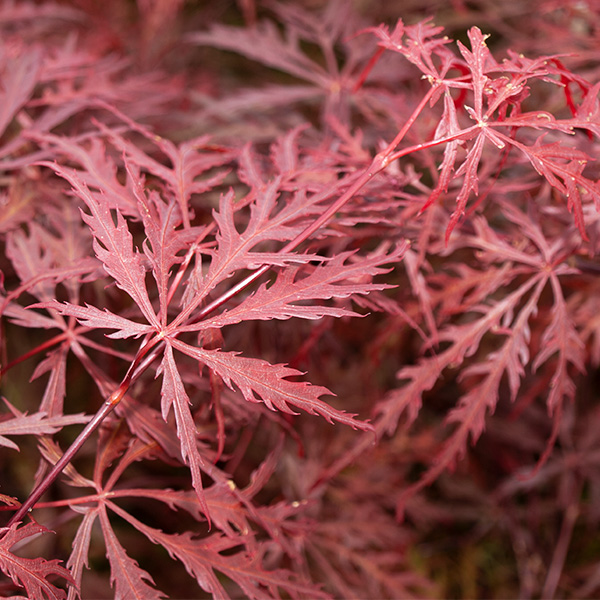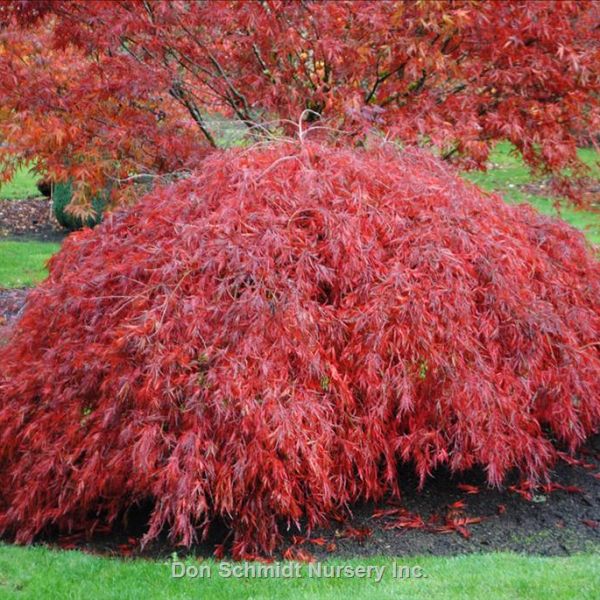

Crimson Queen Japanese Maple
Acer palmatum var. dissectum 'Crimson Queen'
86 reviews
Crimson Queen Japanese Maple
Acer palmatum var. dissectum 'Crimson Queen'
86 reviews
- Beautiful crimson foliage year-round
- Compact size makes it perfect for small gardens or containers
- Attractive weeping habit adds unique visual interest to landscaping
- Recommended by landscape designers for optimal fit in real yards
$153.00
$219.00
30% Off
- Ships to in 7-10 Days
- Free Shipping
- Plant Arrival Guarantee
- In Stock
- Free Plant Consult
$200 - Landscape-Approved: Every Plant We Sell Comes With Design Expertise Behind It
1.5 Gallon 2-3 Feet
We are sorry, product is currently out of stock due to seasonal availability. Please check the "Related plants available in your area" section below
Not just beautiful - intentionally selected by ShrubHub's 3D landscape design team to fit real-world spaces and maximize yard potential.
Why Crimson Queen Japanese Maple?
The Crimson Queen Japanese Maple is a beautiful and popular ornamental tree that provides a stunning display of deep red foliage throughout the year. This slow-growing tree is perfect for adding interest to any garden or landscape, and its elegant, weeping form makes it ideal for use as a specimen or accent plant. With its low maintenance and ease of growth, the Crimson Queen is a favorite among gardeners and landscapers alike.
Sunlight
Crimson Queen Japanese Maple trees prefer partial shade to full sun exposure. They can tolerate a range of sunlight conditions but tend to develop the best color when planted in partial shade, providing protection from hot afternoon sun.
Watering
The watering requirement for Crimson Queen Japanese Maple is moderate. It prefers consistently moist soil but should not be over-watered or allowed to sit in waterlogged conditions. Regular watering and monitoring soil moisture is recommended.
Fertilizing
The fertilizer requirements for Crimson Queen Japanese Maple may vary depending on the soil conditions and specific needs of the tree. It is generally recommended to use a balanced, slow-release fertilizer designed for acid-loving plants and follow the man
The Crimson Queen Japanese Maple is a gorgeous deciduous tree, admired for its beautiful form and vividly colored leaves. Its modest stature makes it a fantastic choice for smaller gardens or urban landscapes, and it adds color and texture to your yard.
The Crimson Queen Japanese Maple requires little care and trimming. However, during hot and dry weather, it is especially crucial to water the tree regularly. The tree should be fertilized once yearly, in the spring, to ensure its continued good health and growth.
This tree does best in organically rich, well-drained soil. It does well in sandy, loamy, and clay soils, among others. Planting in locations with poor drainage, however, is not recommended because it can cause root rot.
The Crimson Queen Japanese Maple is an adaptable tree that thrives in both cold and warm environments. It thrives in USDA plant hardiness zones 5–8, which cover much of the United States. It's best to provide some shade for this tree.
The Crimson Queen Japanese Maple is an attractive tree that may be used to enhance the look of any garden or outdoor space. Its bright red spring and summer leaves are a sight to behold, and its autumn foliage turns a deep scarlet. The gently arching limbs of this tree provide an attractive weeping appearance. You can't go wrong with this tree as a focal point or specimen in your garden. The Crimson Queen Japanese Maple, in general, is a stunning and unusual addition to any garden.
Plant Information:
| Botanical Name: | Acer palmatum var. dissectum 'Crimson Queen' |
| USDA Zones: | 5 - 8 |
| Water: | Moderate |
| Exposure: | Full Sun |
| Soil Needs: | Well Drained |
| Mature Height: | 8 - 10 feet |
| Mature Spread: | 10 - 12 feet |





Pollination Info
Pollination Information for Crimson Queen Japanese Maple
The Crimson Queen Japanese Maple (Acer palmatum var. dissectum 'Crimson Queen') is a deciduous tree that produces seeds through cross-pollination between male and female flowers. The tree produces small, reddish-purple flowers in the spring, which are followed by winged samaras that ripen in the fall.
To achieve cross-pollination, it is important to plant other varieties of Japanese maples nearby, such as the Acer palmatum 'Bloodgood' or 'Emperor'. Bees, butterflies, and other pollinators are attracted to the Crimson Queen Japanese Maple's flowers and play a crucial role in the tree's fertilization process.
In general, Japanese maples are self-incompatible, meaning they cannot fertilize their own flowers. Therefore, it is important to plant different varieties of Japanese maples to ensure successful pollination and seed production.
It is also recommended to plant the Crimson Queen Japanese Maple in a location with full to partial sun and well-drained soil for optimal growth and pollination. Proper care and maintenance, such as watering and fertilizing, can also improve the tree's overall health and increase seed production.
FAQ
Crimson Queen Japanese Maple
Acer palmatum var. dissectum 'Crimson Queen'
Frequently Asked Questions
- What is a Crimson Queen Japanese Maple?
A Crimson Queen Japanese Maple is a small tree or shrub with dissected foliage. It is a cultivar of the Japanese maple (Acer palmatum) that is known for its deep red foliage and weeping habit. It is a popular ornamental tree for landscaping, particularly in small gardens or as a focal point in a larger landscape.
- What are the growing conditions for a Crimson Queen Japanese Maple?
The Crimson Queen Japanese Maple prefers partial shade to full sun and well-drained soil that is rich in organic matter. It tolerates acidic to neutral soil pH levels, and is hardy in USDA zones 5-8. It requires regular watering, especially in hot and dry conditions, and benefits from a layer of mulch to retain moisture and protect the roots.
- How big does a Crimson Queen Japanese Maple grow?
The Crimson Queen Japanese Maple grows about 8-10 feet tall and wide when mature. Its weeping habit gives it a graceful and elegant appearance that makes it an excellent focal point or accent in the garden. It is also suitable for container gardening, provided it is given enough space for its mature size.
- When does a Crimson Queen Japanese Maple leaf out?
A Crimson Queen Japanese Maple typically leafs out in early spring, when temperatures start to warm up. Its leaves are deeply lobed and dissected, and emerge as a reddish-purple color, which then deepens to a rich burgundy-red throughout the growing season.
- Does a Crimson Queen Japanese Maple require pruning?
A Crimson Queen Japanese Maple benefits from selective pruning to maintain its shape and size, as well as to remove dead or damaged wood. It is best to prune during the dormant season, before new growth starts in spring. It is important to avoid excessive pruning, as this can damage the tree and cause it to produce a weaker, less attractive growth.
- How do I propagate a Crimson Queen Japanese Maple?
A Crimson Queen Japanese Maple can be propagated by taking softwood cuttings in early summer, or by using layering or grafting techniques. Propagation is best done by experienced gardeners or horticulturists, as it requires knowledge and skills to ensure successful results.
Planting & Care
Planting and Care for Crimson Queen Japanese Maple
Planting
- Choose a location with well-draining soil and partial shade.
- Dig a hole that is twice the width of the tree's root ball and just as deep.
- Place the tree in the hole, making sure the soil level is at the same height as the surrounding ground.
- Backfill the hole with soil and water thoroughly.
- Mulch around the base of the tree to retain moisture and inhibit weeds.
Care
- Water the tree regularly, especially during dry periods.
- Fertilize in the spring with a balanced fertilizer.
- Prune in the winter to shape the tree and remove any dead or damaged branches.
- Protect the tree from strong winds and excessive sun exposure.
- Keep the area around the tree clear of debris and weeds.
Check Out These Verified Customer Reviews:
Customer Reviews
4.7 out of 5 based on 86 reviews
Thank you! Your review has been submitted.
Easy to navigate website, smooth ordering process
Received in excellent condition, vibrant leaves
The customer service was helpful when I had questions about caring for the tree.
Item has been added to your cart.


